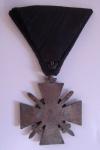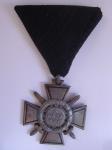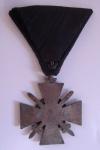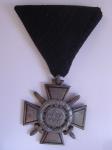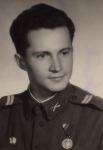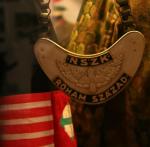-
Posts
2,660 -
Joined
-
Last visited
Content Type
Profiles
Forums
Blogs
Gallery
Events
Store
Everything posted by hunyadi
-

Hungary Kiv?l? Politikai Tiszt & Hat?rőrs?g Badge
hunyadi replied to hunyadi's topic in Central & Eastern European States
Thanks for brinign the thread up - I have found documentation now on the Borderguard badges. The large red star type in Bronze, Silver and Gold was the result of a design competition to replace the 'HV' badge. Unlike the HV badge the bronze was only awarded to individuals who had served for three years or who had caught illegla border crossers - it was open to all ranks and levels. It was relaesed for wear on April 4, 1950. It was worn until April 4, 1953. Then in 1953 the 'Kivalo Karhatalom' badge and the 'Kivalo Hataror' was released to fill the void unitl 1957. In 1957 the oval style (like Verdun's post) 'Kivalo Hataror' was released and was used up to 1970. -

Soviet Unknown Soviet-Hungarian Medal
hunyadi replied to Verdun16's topic in Russia: Soviet Orders, Medals & Decorations
To my knowledge this was a commemorative medal for Soviet troops who were 'invited' to keep the peace in the Hungarian People's Republic after the 1956 revolution.... -

Hungary Hungarian Kivalo Dolgozol Badges
hunyadi replied to hunyadi's topic in Central & Eastern European States
Bryan - Post 227 - you have quite a set of minis. The one on the left is a mini for the Szakam Kivalo Dolgozo (bit of blue enamel left on it) and the mini on the right it for the Magyar Elmunkas (Ace Worker) from 1948-1949. Like you I was told I was throwing away my money if I considered buying any of these when I got here in 2001. Though back then I could buy a WW2 uniform and medals for less than 100 euro....now I cant even get one of the medals for less than 100 euro... but that is a different section and a different time... Now - you need to add a zero to the end of your 200 HUF and multiply several times before you can comprehend the asking price now (you didnt happen to spirit away with some Rakosi era uniforms when you were here - did you?) -
SVA - the irony.....
-

Soviet Budapest "Liberation" Medal
hunyadi replied to hunyadi's topic in Russia: Soviet Orders, Medals & Decorations
Thanks! -

Soviet A sad warning....
hunyadi replied to Stogieman's topic in Russia: Soviet Orders, Medals & Decorations
Lapa - If you look on USA Ebay - you will know who it is..... the quote about reputation was in all his listings. Dont know if if he is still selling on Ebay or not... but not a good reputation -

Soviet Budapest "Liberation" Medal
hunyadi replied to hunyadi's topic in Russia: Soviet Orders, Medals & Decorations
Thank you Miguel - Its a very nice city for certian. There are so many scars from the war and the 1956 Revolution still around. Does anyone know what type this is - early, mid, late??? -

Soviet Budapest "Liberation" Medal
hunyadi replied to hunyadi's topic in Russia: Soviet Orders, Medals & Decorations
-

Soviet Budapest "Liberation" Medal
hunyadi posted a topic in Russia: Soviet Orders, Medals & Decorations
After living in the liberated city for over 7 years - I have hardly encountered these medals (belive it or not). I have th eopportunity to purchase this example, but I know they are heavily faked. Any opinions on this one. Seller states its a "Type 2"... Any help apreciated. -
-
Though I posted this in the Wound Badge section - thought we could updated this thread a bit: A very rare and hard to find in original period form, this is the black ribboned form of the Fire Cross 1st Class awarded to the next of kin of a fallen front line soldier. Certianly black ribbon is available, but the stiff silk and the period hardwear date this object to wartime production. This is the first original black trifold I have been able to aquire.
-
-
A rather rare and elusive award of the Hungarian Fire Cross in any class in the Posthumious Next of Kin award. Though the only difference from the regular award is a black ribbon - real ribbons with the period construction and textile qualities hardly ever appear. I was luck enough to find this original example of a 1942 awarded piece for a front line soldier.
-

Hungary Distinction Badges of the HUPR Military
hunyadi replied to Gordon Craig's topic in Central & Eastern European States
-

Hungary Distinction Badges of the HUPR Military
hunyadi replied to Gordon Craig's topic in Central & Eastern European States
This past week I spent looking through nearly every issue of "Nephadsereg" - the offcial newspaper of the Hungarian People's Army. In the regulations concering these badges, it was stipulated that those who were awarded any form of the badge, the name had to be 'published'. In nearly every issue there was a section which contained the names and a short bio of the recipients. Generaly there was only one name, ocasionally two per day. This covered all of the badges, not just specific forms. In tootal I looked through the years 1950-1956. Calculating 365 days per year for six years = 2190. Addsing in a factor that some issues had two - average in about 500 more give you a total of all badges of all forms awarded was less than three thousand (2690). The awards were open to the ministry of the interior and looking through their daily newspaper the statistics are slighly less. Generally there was a name published about every three days or roughly 730 additional awards of badges over a six year period. Additionally, there were also a few individuals who were awarded multiple badges due to their 'hard work'. So factor in at least 200 in all services. 2690+730+200= 3620 awards over a period of six years. This is a rough estimate at best, but I would say fairly within the ballpark - round it up to 5000 total and its a reasonable assumption. Conversely, I have been colleciting hundreds of period photographs, and less than 1% contain a photo in which an individual is wearing any one of these badges... just food for thought on the rarity of the badges. -
One never knows what one will find. While doing research and turning every page of the newspaper "Nephadsereg" from 1950 to 1956, I found this little bit of information in the October 20th, 1955 issue. Two things must be realized: 1) There are NO official documents or regulations for the year of 1955. Anythign that was created for wear during that time has no "official" published material about it. 2) As such - its likely that this badge was introduced in 1955 and worn for a brief time into the 1960's. (where I have seen them in wear in a photo album) But since there is no official documentation - no idea on what one could even get the badge for.
-

Romania J?zsef Attila-Poet
hunyadi replied to Gordon Craig's topic in Central & Eastern European States
DISZ did have enrolement up to the age of thirty, but one published source did mention that some were even 36 years old, primarily the older ones were the group leaders and such. DISZ took a huge boost in numbers when SZIT and the other trade youth groups became absorbed in June of 1950. Many of these organiztaions were not so stringent on members bening younger than 30. The young corporal in the photo was more than likely a conscript as the inscription on the back is "Remembering [time of service], Laci 1955" so he probably entered in 1954, participated in the flood of 1954 then mustered out after his 1 year term. Almost every conscript reached the rank of corporal. If you made it to NCO - then that meant that the Honved could hold you for an additional 12 months. So most "played dumb" - so they would not get promoted before their time was up. Made a huge problem for combat effectivness. -

Hungary SZOCIALISTA KULT?R??RT KIT?NTETO JELV?NY
hunyadi replied to Gordon Craig's topic in Central & Eastern European States
Very nice little find - you never know what you get when you pick up a pile of papers like that! -

Romania J?zsef Attila-Poet
hunyadi replied to Gordon Craig's topic in Central & Eastern European States
Period Wear photo - hard to say if this individual is Infantry or Border Guard - if he was wearing his cap I could tell you! -
Enzo - Very interesting - never heard about this order before and have never seen one either. Can you scan the article for us? If they produced such items I would wonder what the other grades look like.
-
Ilja - you wont find information about this cross as its a fantasy piece. The crown device is from a Order of St Istvan, but probably from one of the recent fakes produced in Austria. The central medalion is from a Hungarian Order of The Holy Crown and the red enameled cross may be from a Order of St Istvan - but it does not match. The Order of St Istvan should be enameled in green. I hope you did not buy this item!
-

Hungary Hungarian Field Police
hunyadi replied to Gordon Williamson's topic in Central & Eastern European States
The term 'Field Security' is probably bettter - though my understanding was that they were simply MP's - in camp or barracks situations...so take your pick... The Csendor and NSZK Gorgets do show up from time to time - but you are correct - the Tabori are the more common. AS for fakes in the 1970's; all one has to do is look at the Pilots Dress Daggers - another item whose dies survived the war....these have been made for the collcetors here as far back as then. I cna't really explain the need for it back then - but people today make a pretty penny on Ebay for some very questionable examples... -

Hungary Hungarian Field Police
hunyadi replied to Gordon Williamson's topic in Central & Eastern European States
Gordon - The Csendor (Field Police - Gendermarie) gorget was introduced in August of 1944 so that German forces could easily recognize the security forces. This was follwed in November of 1944 by the "Tabori Biztonsag" (Camp Security Forces) and finnaly by the NSZK (Nemzeti Szamonkeres Kozpontja - Central National "Rekoning" - IE - Jewish and Communist cleansing forces) Roham Szazad (Battle Company) This particular gorget was introduced in the early weeks of 1945. Yes - they are heavily faked and from my information from surviving dies. I have had many opportunities to aquire one, but with little certainty that any of them are original period items. As these were manufactured in the last days of the war in Hungary I doubt that few have survived. Below is a photo of the rare NSZK gorget from the Hungarian Military Museum for comparison






